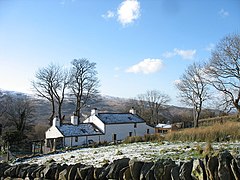Dinorwig
Dinorwig
Village near Llanberis in Gwynedd, Wales
Dinorwig (/dɪˈnɔːrwɪɡ/ din-OR-wig; ; Welsh: [dɪˈnɔrwɪɡ]), historically spelled as Dinorwic in English, is a village located high above Llyn Padarn, near Llanberis, in Wales. The name is shared with the fort of Dinas Dinorwig, also within the community of Llanddeiniolen, on a foothill 6 kilometres (3.7 mi) from Dinorwig village and 3 kilometres (1.9 mi) from the Menai Strait[1] and also with Port Dinorwic, the anglicised name of Y Felinheli. It lies around a mile from the larger settlement of Deiniolen.
This article includes a list of general references, but it lacks sufficient corresponding inline citations. (October 2016) |

